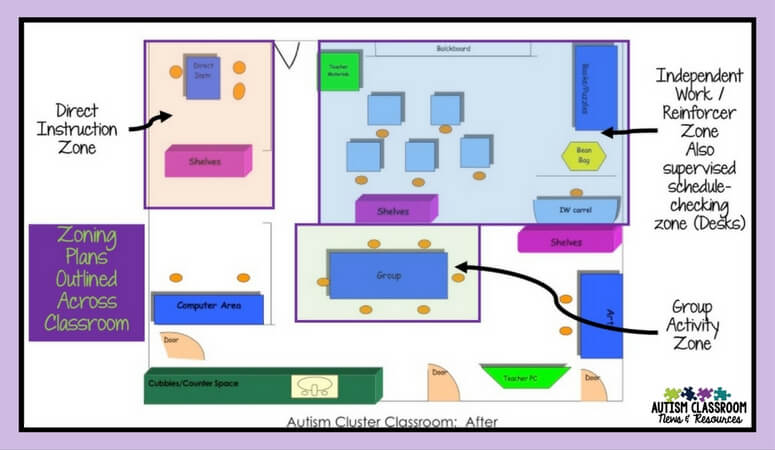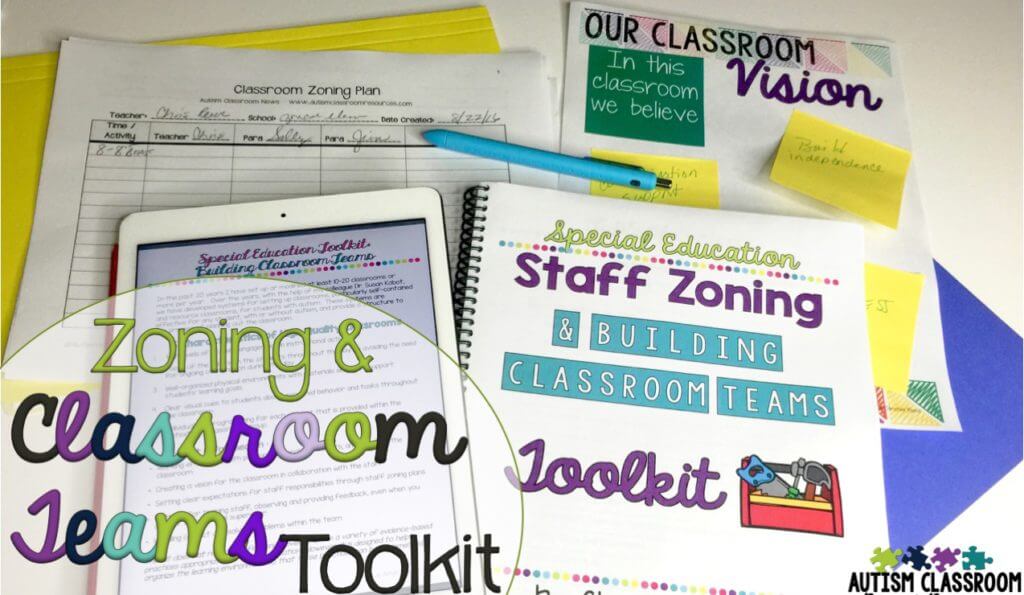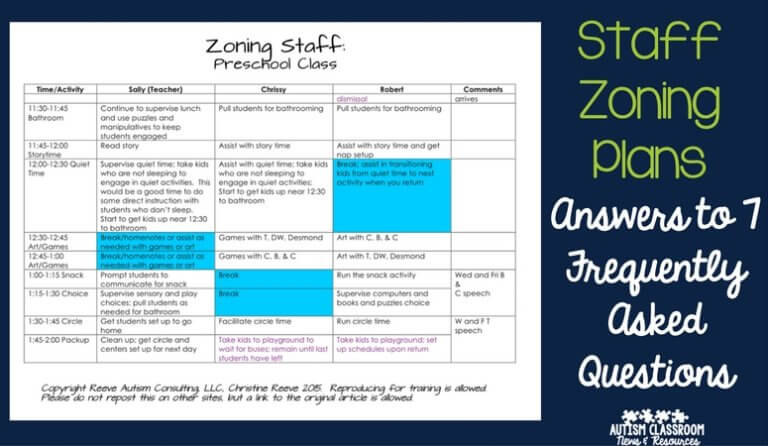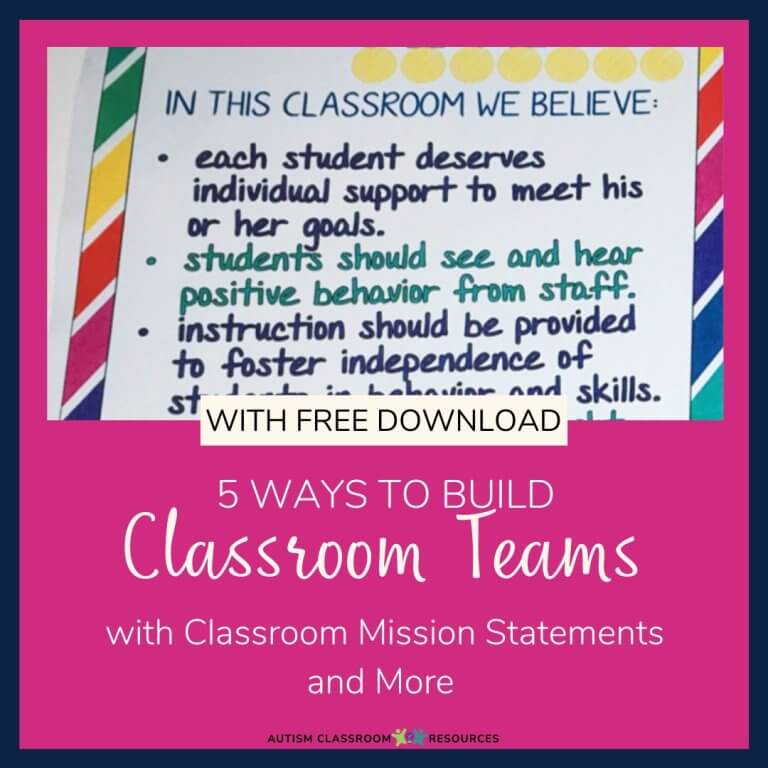Today I’m introducing staff zoning plans as a way to organize the staff responsibilities in the classroom. Throughout the 10 Steps to a Well-Run Special Education Classroom, I’ve emphasized the importance of building systems within the classroom that will run on their own with little attention (once they are set up). To me a well-run classroom involves all the staff being involved with the students as much as possible. This means we spend little time having to direct each other or ask questions of other staff. To do this, you need a good system and a good team. Today I want to talk about how to set up the system. I’ve talked about how to develop good teams in a previous series you can check out.
 I’ve talked about staff zoning plans in the past and I’ll include links at the end that you can check out to learn more. Today I want to talk about what “zoning” means (i.e., how it got its name). I also want to share ways you can use the actual process to make your classroom run more efficiently.
I’ve talked about staff zoning plans in the past and I’ll include links at the end that you can check out to learn more. Today I want to talk about what “zoning” means (i.e., how it got its name). I also want to share ways you can use the actual process to make your classroom run more efficiently.
What is a Staff Zoning Plan?
A zoning plan, the way that the term has come to be used, is just a schedule for the staff. It’s an outline of every duty that needs to be completed to make the class run smoothly. It reduces the amount of time that you have to spend verbally directing staff which allows everyone to engage more with the students. For an example of a zoning plan check that out. And you can see 10 things you should think about putting in a zoning plan.
What is a Zone in a Staff Zoning Plan?
If you are a basketball fan, this term will make perfect sense to you; if not, hang with me and I’ll explain. In basketball teams often form a zone defense. This means that a player covers an area of the court instead of a specific player on the opposing team (which would be a man-on-man defense). If a player leaves the area, he enters another zone and another player is responsible for him. If a player enters your zone, you are responsible for defending against him.
In special education, the term actually comes from a journal article that looked at creating zones of a daycare classroom and the impact on student engagement in activities. Essentially they found that using a zone approach (where a teacher was zoned to the bathroom, another to the table and children went back and forth between them) resulted in higher engagement and less downtime than a man-to-man approach. A man-to-man approach would require the teacher to go to the table, get one student, take him or her to the bathroom, take that student back to the table, get another, and so on. It also might mean that students have to wait in the bathroom for their turn. Instead in a zoning system, the students wait at the table and go to the bathroom when it is their turn. Hence they stay more engaged.
Do You Have to Use Zones in a Zoning Plan?
The short answer is no. You could create a zoning plan with just man-to-man coverage if you had enough staff or use a combination of zones and man-to-man. Most plans will involve a combination. The zone approach works well when you have activities that take place in different spots and either students who can transition independently OR someone who can be zoned to the transition area.
What Does a Zoning Approach Look Like?
Here’s an example: In the morning, most busses do not arrive at the same time, so there is always some waiting time for some students at the beginning of the day. You don’t want to start a new activity because you don’t have all the students. But if you wait, you have students who are not engaged. And we all know that downtime is not your friend in a special education classroom. So, we often set up an activity that students can come and go from without missing anything. Sometimes like table tasks where the students engage with puzzles and work tasks like they use in independent work. For zoning, let’s say we have 3 staff. One staff mans the outside where the busses and cars come in. One staff mans the table back in the room. And one staff brings students in small groups from outside to the table tasks table. When the students move from one area to another, the responsibility for supervision moves to the new zone. When all the students are in, the bussing person comes inside and you can begin to move on to the next activity.
Do I Have to Give Staff Breaks on the Zoning Plan?
In all of my posts about zoning, I talk about the importance of giving breaks to all the staff (the teacher included). And this is probably the most asked question I hear. My answer is YES, Why yes you do!. I know that many of you are used to having staff take breaks when things seem quiet or checking with each other. But that checking with each other takes time for you to coordinate it on the spot. And, it means that sometimes those breaks don’t happen. Many times you are used to not giving breaks and don’t think there is time for that in your class. And what happens in those situations is that staff eventually “zones out” [see what I did there?] when it’s not a good time, often while looking like they are supervising the student. This leads to obvious problems. In addition, I believe that it leads to higher staff burnout than we already have in our classrooms.
Simply put, EVERYONE NEEDS A BREAK! Even YOU! If you plan for the breaks, you can assure that the breaks are taken at times that students are supervised and engaged by other staff members. You can adjust the schedule so that perhaps you have fewer things going on while breaks are being taken. I’ve made many schedules that looked great until I started thinking about the zoning plan and then had to go back and make some adjustments. While staff take lunch breaks, I might set up leisure centers or a choice time where students are still engaged in meaningful learning but can do so with less staff to keep them involved.
What if My Staff Can Choose Not To Take a Break?
In some districts, paraprofessionals might be given the option of leaving 15 minutes early by not taking a break during the day or something similar. In those situations, I still think it’s important to give them a break, but the break time might look different. Rather than a time to leave the room, hang out in the lounge, or go to the cafeteria, the break might involve prep for the classroom. It would take them away from the students for a short period of time, but will give them a mental break from supervising and teaching. It also lessens the load on you because you have someone who can do some material prep for you.
How Do You Develop the Plan?
I write the zoning plan often as a draft on my own. I share it with the staff and see if they are OK with it. I get their feedback and factor it into the plan. Then we run the plan. During the day I keep a notebook in the center of the classroom or a pad in my pocket. I jot things down as I realize they got left off the list (e.g., the walkie talkie didn’t go to PE with us because we all thought someone else had it). Then I make revisions. As I make revisions I work with the staff to get their input on what activities they think are working or not working. then I make changes based on that so it is their plan as much as mine. That builds us effectively as a team in the classroom.
So, those are some answers to some of the most common questions I get asked about zoning plans. You can check out the posts below for answers to some other questions and some ideas, as well as examples. I have created a Building Classroom Teams and Zoning Staff Toolkit that is available in my TpT Store. It includes 8 examples of different zoning plans, directions, a cheat sheet and a checklist as well as ideas about how to build relationships with staff and manage classroom conflict. You can check it out in my store here.
- Successfully Working with Paraprofessionals Using Zoning Plans
- Making Zoning Plans Work for Everyone: Back to School Setting Up Classrooms for Students with Autism
- Top 5 Reasons to Zone Staff: Back to School-Staff Zoning Staff-High School General Ed (and freebie!)
- 10 Ways to Create Time and Make the Most of Your Collaboration with Paraprofessionals
- Top 10 Things to Remember When Zoning Staff: Back to School-Setting Up Classrooms for Students with Autism
- 3 More Reasons to use a Zoning Plan in Your Classroom
Are you looking for more help and guidance with classroom collaboration, as well as creating zoning plans in your own room? Check out the Building Classroom Teams and Zoning Plans Manual. It has a video tutorial, forms, instructions, suggestions for working with staff, as well as cheat sheets and tips. You can read more about it here as well as see a video!
In the meantime, if you have more questions feel free to leave them in the comments.
Until next time
Today I’m introducing staff zoning plans as a way to organize the staff members and their responsibilities in the classroom. Throughout the 10 Steps to a Well-Run Special Education Classroom, I’ve emphasized the importance of building systems and a comprehensive plan within the classroom that will run on their own with little attention (once they are set up). To me a well-run classroom involves all the staff being involved with the students as much as possible. This means we spend little time having to direct each other or ask questions of other staff. To do this, you need a good system and a good staff support team. Today I want to talk about how to set up the high quality system. I’ve talked about how to develop a good team and in a previous series you can check out.
 I’ve talked about staff zoning plans in the past and I’ll include links at the end that you can check out to learn more. Today I want to talk about what “zoning” means (i.e., how it got its name). I also want to share ways you can use the actual process to make your classroom run more efficiently.
I’ve talked about staff zoning plans in the past and I’ll include links at the end that you can check out to learn more. Today I want to talk about what “zoning” means (i.e., how it got its name). I also want to share ways you can use the actual process to make your classroom run more efficiently.
What is a Staff Zoning Plan?
A zoning plan, the way that the term has come to be used, is just a schedule for the staff. It’s an outline of every duty that needs to be completed to make the class run smoothly. It reduces the amount of time that you have to spend verbally directing staff which allows everyone to engage more with the students. For an example of a zoning plan check that out. And you can see 10 things you should think about putting in a zoning plan.
What is a Zone in a Staff Zoning Plan?
If you are a basketball fan, this term will make perfect sense to you; if not, hang with me and I’ll explain. In basketball teams often form a zone defense. This means that a player covers an area of the court instead of a specific player on the opposing team (which would be a man-on-man defense). If a player leaves the area, he enters another zone and another player is responsible for him. If a player enters your zone, you are responsible for defending against him.
In special education, the term actually comes from a journal article that looked at creating zones of a daycare classroom and the impact on student engagement in activities. Essentially they found that using a zone approach (where a teacher was zoned to the bathroom, another to the table and children went back and forth between them) resulted in higher engagement and less downtime than a man-to-man approach. A man-to-man approach would require the teacher to go to the table, get one student, take him or her to the bathroom, take that student back to the table, get another, and so on. It also might mean that students have to wait in the bathroom for their turn. Instead in a zoning system, the students wait at the table and go to the bathroom when it is their turn. Hence they stay more engaged.
Do You Have to Use Zones in a Zoning Plan?
The short answer is no. You could create a general plan with just man-to-man coverage if you had enough staff or use a combination of zones and man-to-man. Most plans will involve a combination. The zone approach works well when you have activities that take place in different spots and either students who can transition independently OR someone who can be zoned to the transition area.
What Does a Zoning Approach Look Like?
Here’s an example: In the morning, most busses do not arrive at the same time, so there is always some waiting time for some students at the beginning of the day. You don’t want to start a new activity because you don’t have all the students. But if you wait, you have students who are not engaged. And we all know that downtime is not your friend in a special education classroom. So, we often set up an activity that students can come and go from without missing anything. Sometimes like table tasks where the students engage with puzzles and work tasks like they use in independent work. For zoning, let’s say we have 3 staff. One staff mans the outside where the busses and cars come in. One staff mans the table back in the room. And one staff brings students in small groups from outside to the table tasks table. When the students move from one area to another, the responsibility for supervision moves to the new zone. When all the students are in, the bussing person comes inside and you can begin to move on to the next activity.
Do I Have to Give Staff Breaks on the Zoning Plan?
In all of my posts about zoning, I talk about the importance of giving breaks to all the staff (the teacher included). And this is probably the most asked question I hear. My answer is YES, Why yes you do!. I know that many of you are used to having staff take breaks when things seem quiet or checking with each other. But that checking with each other takes time for you to coordinate it on the spot. And, it means that sometimes those breaks don’t happen. Many times you are used to not giving breaks and don’t think there is time for that in your class. And what happens in those situations is that staff eventually “zones out” [see what I did there?] when it’s not a good time, often while looking like they are supervising the student. This leads to obvious problems. In addition, I believe that it leads to higher staff burnout than we already have in our classrooms.
Simply put, EVERYONE NEEDS A BREAK! Even YOU! If you plan for the breaks, you can assure that the breaks are taken at times that students are supervised and engaged by other staff members. You can adjust the schedule so that perhaps you have fewer things going on while breaks are being taken. I’ve made many schedules that looked great until I started thinking about the zoning plan and then had to go back and make some adjustments. While staff take lunch breaks, I might set up leisure centers or a choice time where students are still engaged in meaningful learning but can do so with less staff to keep them involved.
What if My Staff Can Choose Not To Take a Break?
In some districts, paraprofessionals might be given the option of leaving 15 minutes early by not taking a break during the day or something similar. In those situations, I still think it’s important to give them a break, but the break time might look different. Rather than a time to leave the room, hang out in the lounge, or go to the cafeteria, the break might involve prep for the classroom. It would take them away from the students for a short period of time, but will give them a mental break from supervising and teaching. It also lessens the load on you because you have someone who can do some material prep for you.
How Do You Develop the Plan?
I write the zoning plan often as a draft on my own. I share it with the staff and see if they are OK with it. I get their feedback and factor it into the plan. Then we run the plan. During the day I keep a notebook in the center of the classroom or a pad in my pocket. I jot things down as I realize they got left off the list (e.g., the walkie talkie didn’t go to PE with us because we all thought someone else had it). Then I make revisions. As I make revisions I work with the staff to get their input on what activities they think are working or not working. then I make changes based on that so it is their plan as much as mine. That builds us effectively as a team in the classroom.
So, those are some answers to some of the most common questions I get asked about zoning plans. You can check out the posts below for answers to some other questions and some ideas, as well as examples. I have created a Building Classroom Teams and Zoning Staff Toolkit that is available in my TpT Store. It includes 8 examples of different zoning plans, directions, a cheat sheet and a checklist as well as ideas about how to build relationships with staff and manage classroom conflict. You can check it out in my store here.
- Successfully Working with Paraprofessionals Using Zoning Plans
- Making Zoning Plans Work for Everyone: Back to School Setting Up Classrooms for Students with Autism
- Top 5 Reasons to Zone Staff: Back to School-Staff Zoning Staff-High School General Ed (and freebie!)
- 10 Ways to Create Time and Make the Most of Your Collaboration with Paraprofessionals
- Top 10 Things to Remember When Zoning Staff: Back to School-Setting Up Classrooms for Students with Autism
- 3 More Reasons to use a Zoning Plan in Your Classroom
Are you looking for more help and guidance in working with paraprofessionals and classroom collaboration, as well as creating zoning plans in your own room? Check out the Building Classroom Teams and Zoning Plans Manual. It has a video tutorial, forms, instructions, suggestions for working with staff, as well as cheat sheets and tips. You can read more about it here as well as see a video!
In the meantime, if you have more questions, feel free to leave them in the comments.
Until next time,
,







